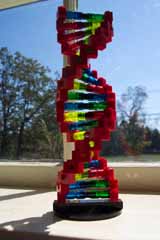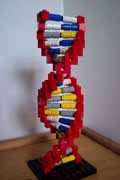

Since building the first large double helices for AMGEN I have received a fair number of emails asking about the sale, renting, or other use of the models.
Unfortunately, I have long ago disassembled the big blue-ribboned prototype that I had made, and the two that were AMGEN's property had been given away to hospitals or something.
I still had the basic schematics, and certainly could reconstruct a helix of the original size, but new clients generally found the couple thousand dollar price tag a bit too high.
Then, one day, I was approached by an editor of a genetics journal who said that his magazine might have an interest in wanting a photograph of the helix for their cover. Now, I didn't have any pictures of the helices beyond the ones on my website, and certainly none of high enough quality to produce an 8.5" x 11" picture at 300 dpi.
Some discussion was made about my possibly rebuilding an unglued helix that I would then photograph myself (since shipping the unglued model would be disastrous). But, I could not guarantee that my photographs would be of the best quality, and, thus, the journal could not guarantee that it would use the images (and I would not be monetarily compensated for my time unless the photos were used).
So, I thought this would be a 'no go'.
Shortly thereafter, however, I had a revelation: why not build a much smaller version of a DNA helix?
In addition to the obvious benefits of shorter building time, easier shipping, and less cost in materials, I realized that for the cover of a magazine or such, a smaller model might actually look better. A closer shot would ensure that the bricks were more noticable.
I was able to quickly build the miniature helix that you see on this page. This version has a few improvements over its larger cousin. First, it is built with the proper 'twist'. AMGEN had failed to tell me during the original construction that DNA molecules are supposed to twist to the right as one goes up; I had built the large versions backward (I never studied genetics in high school or college, so I knew nothing about DNA, really).
Secondly, this smaller version does not need a central support column to hold itself up. Even without gluing the model holds together because it is so light (I still glue it so that it will survive shipping).
Finally (and this is complete LEGO-luck), I did my homework and learned that a DNA helix is supposed to make one complete rotation every 10.5 rods. Now, this was nice to know, but I was not going to worry about it, really. I was content to build one as planned and count the rods per turn afterward to see how close I came.
Well, I did count. How many rods are used in each rotation of the miniature LEGO DNA model?
I'm not kidding. It's almost exactly 10.5. Spooky.
Oh, did I say I hadn't planned it?
Anyway, back to the story. The one editor of the journal likes the new model (and the fact that the cost would be significantly less); however, he is just one of several editors for the journal, and evidently some aren't too keen on the idea of putting a "toy" on the cover. So, it's still in discussion.
In the meantime, however, it turns out that a fellow who works for the U.S. Patent and Trademark Office in the biotechnology division was also interested in the DNA helices; he sent me an email asking if they could rent, buy, or borrow one of the large models.
Of course, there are all those problems associated with the large version, but what'd'ya know... I happen to have this little model sitting right in front of me.
He liked it; he bought it.
Now, if the journal does end up wanting one of their own, I'll have to scurry off to Bricklink to order more 1x1 round bricks...
I have also built a version of this size helix using transparent 1x1 cylinders (the base is also round now).